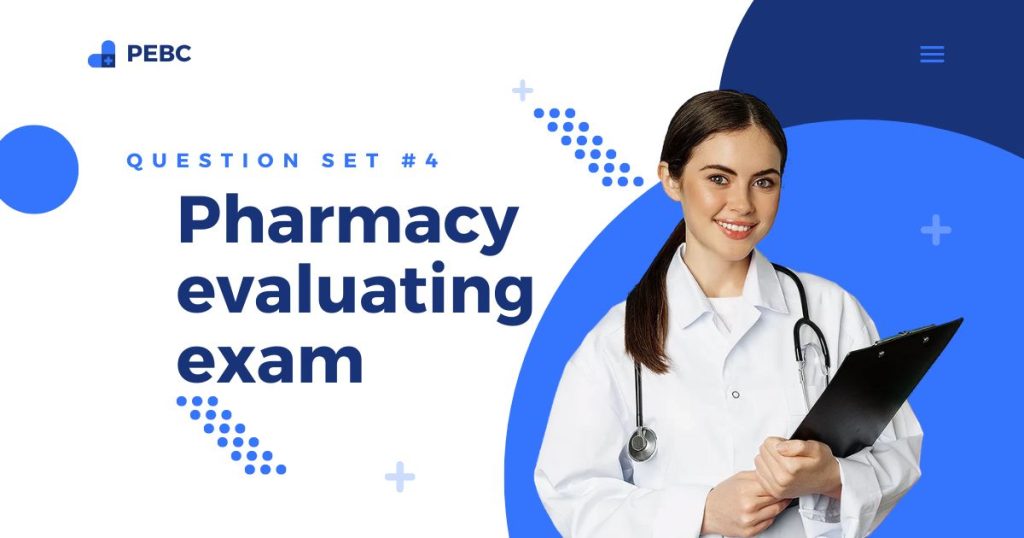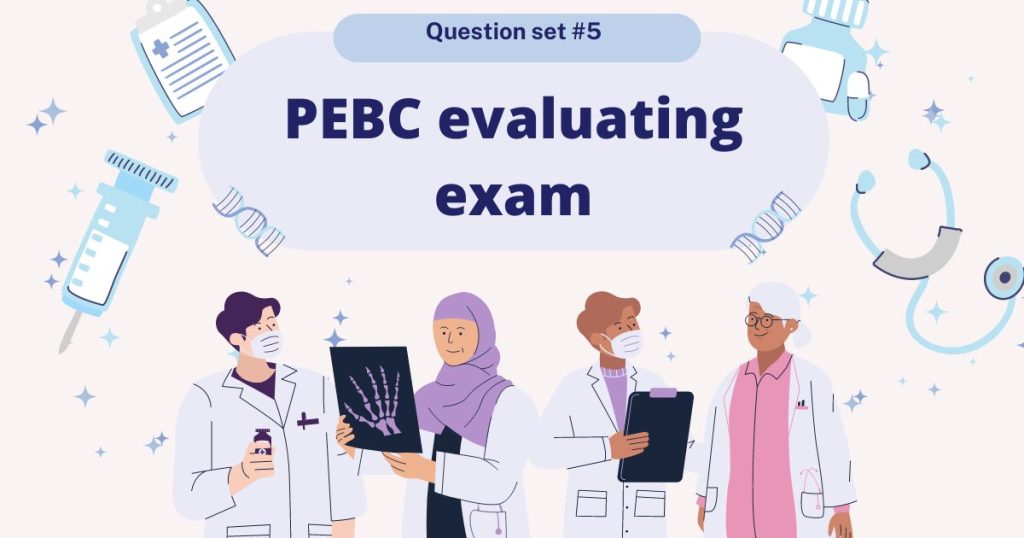Question 1: Out of the following diseases, which one is preventable by vaccination?
A. AIDS
B. Tuberculosis
C. Pertussis
D. Typhoid
E. Encephalopathy
Click here to see the answer
Answer: C
Quick revision: Pertussis for PEBC evaluating exam
What is Pertussis
Pertussis is a highly contagious respiratory tract infection caused by Bordetella pertussis. It is also known as whooping cough.
The most prominent symptom of Pertussis is a high-pitched intake of breath which sounds like a ‘whoop’.
Question 2: Which vaccine is given at the age of 12 – 18 months and a booster dose at the age of 4 – 6 years?
A. DTap
B. Influenza
C. Sabine Polio
D. Rotavirus
E. MMR
Click here to see the answer
Answer: E
Varicella and MMR are the 2 vaccines that are given at the ages of 12 – 18 months and 4 – 6 years.
Question 3: A 64-year-old man with type 2 diabetes and a history of myocardial infarction is taking atorvastatin 40 mg daily. He presents with muscle pain and weakness. Labs show normal CK (creatine kinase) levels.
Question:
What is the most appropriate next step?c nerve innervate?
A. Discontinue statin permanently
B. Continue atorvastatin and add coenzyme Q10
C. Switch to pravastatin
D. Switch to rosuvastatin
E. Reduce dose of atorvastatin
Click here to see the answer
Answer: C
Explanation:
Pravastatin is less lipophilic and less likely to cause muscle-related side effects. It’s a safer alternative for patients with statin-associated muscle symptoms despite normal CK.
Question 4: Which of the following statements about relative risk reduction (RRR) is true?
A. RRR is unaffected by the baseline risk of the event.
B. RRR is always greater than absolute risk reduction (ARR).
C. RRR provides an estimate of the treatment's effect size relative to the control.
D. RRR can only be calculated for binary outcomes.
E. RRR is equivalent to the number needed to treat (NNT).
Click here to see the answer
Answer: C
Question 5: Which of the following statements describes the best reason for employing blinding in a clinical trial?
A) Ensure participants receive the correct treatment
B) Prevent the investigators from knowing the results
C) Reduce placebo effects and increases drug effects
D) Minimize bias in treatment assessment and data collection
E) Blinding permits participants to switch treatments freely
Click here to see the answer
Answer: D
Question 6: A 42-year-old female on fluoxetine for depression is started on tramadol for post-surgical pain. A day later, she develops agitation, tremors, hyperreflexia, and fever.
Question:
What is the most likely diagnosis?
A. Opioid withdrawal
B. Neuroleptic malignant syndrome
C. Tramadol toxicity
D. Serotonin syndrome
E. Malignant hyperthermia
Click here to see the answer
Answer: D
Explanation:
Both fluoxetine (SSRI) and tramadol increase serotonin. Their combination can lead to serotonin syndrome, characterized by mental status changes, autonomic instability, and neuromuscular abnormalities.
Question 7: Which of the following methods is employed to remove pyrogens from parenteral preparations?
A. The Rabbit Pyrogen Test method
B. Distillation
C. Terminal sterilisation with moist heat
D. Double distillation
E. Filtration
Click here to see the answer
Answer: D
Question 8: What are the symptoms of Schizophrenia?
A. Delusion and halluciantion
B. Aphaisa
C. Anomia
D. Excessive sleeping or not sleeping at all
E. Restlessness and agitation
Click here to see the answer
Answer: A
Question 9: Which of the following is a diagnostic test for pneumonia?
A. Fecal Occult Blood Test
B. Urine test to detect infection
C. Semen analysis
D. Biposy
E. Chest X ray
Click here to see the answer
Answer: E
A chest X-ray is done to look for the location and extent of inflammation in the lungs. Consolidation in chest X-ray is the confirmatory diagnosis.
Question 10: Which of the following statements is not correct for the Dukoral oral vaccine?
A. Dukoral vaccine is effective against E. coli and Vibrio cholera
B. Cannot be given to immunocompromised individuals
C. Dukoral is the only inactivated vaccine which can be given to immunocompromised patients
D.Dukoral needs 2 doses in order to be effective
E. Dukoral is suitable for childern above 2 years
Click here to see the answer
Answer: C
Dukoral cannot be given to immunocompromised patients.
Question 11: Which of the following types of immunity is acquired from vaccinations?
A) Passive immunity
B) Innate immunity
C) Active immunity
D) Natural immunity
E) Autoimmune immunity
Click here to see the answer
Answer: C
Quick revision: Active vs Passive immunity for PEBC evaluating exam
What is the difference between active and passive immunity?
Active immunity: Antigen enters the body and the body responds by making its own antibodies and B-memory cells. Active immunity has slow onset but a long duration of action.
Passive immunity: Antibodies are administered directly to provide short-term or temporary immunity. This is fast-acting since preformed antibodies are administered in the body.
Question 12: A 68-year-old man with type 2 diabetes and heart failure with reduced ejection fraction (HFrEF) is taking metformin. His HbA1c is 8.5%. The physician plans to add a second agent to optimize glycemic control and reduce cardiovascular risk.
Question:
Which of the following is the most appropriate medication to add?
A. Sitagliptin
B. Glipizide
C. Empagliflozin
D. Pioglitazone
E. Acarbose
Click here to see the answer
Answer: C
Explanation:
SGLT2 inhibitors like empagliflozin are preferred in patients with T2DM and HFrEF, as they reduce both cardiovascular events and hospitalization for heart failure.
Question 13: If clearance of a drug remains constant and the volume of distribution increases, which of the following statements about the drug’s half-life is true?
A. Cannot be mathematically determined.
B. Half-life of the drug increases
C. Half-life of the drug decreases
D. Kel is required to determine the half-life
E. Cannot be determined without ionisation constant
Click here to see the answer
Answer: B
Question 14: The volume of distribution for a drug is 12 liters and it’s plasma clearance is 4 L/hour. What is the shelf life of the drug?
A. 19.81 hours
B. 21.11 hours
C. 2.079 hours
D. 20.79 hours
E. 12.4 hours
Click here to see the answer
Answer: A
Step 1: Plug in values for Vd and Cl in the formula t1/2 = 0.693 x (Vd/Cl) = 0.693 x 12/4 = 2.079 hours
Step 2: Calculate shelf life using the formula t90 = t1/2/0.105 = 2.08/0.105 = 19.81 hours
Most of the calculations from pharmacokinetics will be a 2-step calculation.
Question 15: JT comes to the pharmacy with a new prescription of Tramadol for her 78-year-old mother. While counseling, the pharmacist came to know that JT’s mom has a non-anaphylactic allergy to tramadol. JT also mentioned that his mom did not experience any allergy symptoms when she used Tapentadol the last time her doctor prescribed the drug. Which of the following is the best course of action?
A. Dispense Tramadol as the allergy is non-anaphylactic in nature
B. Change the drug to Tapentadol under the principle of 'adapting the prescription'
C. Call the doctor and let him know about this new information and ask to change the drug
D. Dispense the Rx and recommend an OTC anti-histaminic
E. Do not dispense tramadol and recomment Tylenol
Click here to see the answer
Answer: C
Adapting the prescription is when a pharmacist changes the dose, dosage form, or drug based on the pharmacist’s assessment of the patient. A pharmacist does not have the authority to change the prescription of a narcotic, controlled, or targeted drug. Hence, the patient has to be referred back to the doctor.
Question 16: which of the following is a risk factor for Afib?
A. Hyperthyroidism
B. Tuberculosis
C. HIV
D. Diabetes Mellitus
E. Encephalopathy
Click here to see the answer
Answer: A
Hyperthyroidism is a risk factor for Afib
Quick revision for symptoms of Hyperthyroidism:
| Mnemonic | THYROID RACING |
| T | Tachycardia |
| H | Heat |
| Y | Weight Loss |
| R | Restlessness |
| O | Oligomenorrhea |
| I | Insomnia |
| D | Diarrhea |
| R | Racing thoughts |
| A | Anxiety |
| C | Cold skin due to sweating |
| I | Insomnia |
| N | Nervousness |
| G | Goiter |
Question 17: JT is a pregnant woman. She just got diagnosed with gestational diabetes. Which of the following is the most suitable drug for JT?
A. Meformin
B. Empagliflozin
C. Semaglutide
D. Glyburide
E. Insulin
Click here to see the answer
Answer: E
Metformin and Glyburide are approved for use in pregnancy, but switch to insulin as soon as you can. If you are taking metformin or glyburide, continue taking them until you see your doctor.
TIP: All insulins are schedule II (Behind The Counter or BTC) and pharmacists can recommend without a prescription.
Question 17: Which of the following drugs causes SLE?
A. Meformin
B. Infliximab
C. Atorvastatin
D. Valproic acid
E. Carbidopa
Click here to see the answer
Answer: B
Mnemonic for drugs that cause SLE: HIPPPEMCQ
H – Hydralazine, I – Isoniazid, P – Procainamide, P – Phenytoin, P – Penicillamine, I – Infliximab, E – Etanercept, M – Methyldopa, C – Chlorpromazine, Q – Quinidine
Question 18: Which of the following statements is true about a case-control study?
A. A study that follows a group of people over time to assess the effects of certain exposures.
B. A study that randomly assigns participants to treatment or control groups to evaluate the effect of interventions.
C. A study that compares individuals with a specific condition (cases) to individuals without the condition (controls) to identify risk factors.
D. A study that examines the incidence and prevalence of diseases in a population at a single point in time.
E. A study that systematically reviews and analyzes multiple research studies on a particular topic.
Click here to see the answer
Answer: C
Question 19: Which of the following are examples of topical antihistaminics?
A. Diclofenac
B. Capsaicin
C. Bacitracin
D. Levofloxacin
E. Oloptadine
Click here to see the answer
Answer: E
Question 20: How are participants selected in a randomized clinical trial?
A. By a computer generated code which is not dependent on any criteria
B. Individually grouped by investigator
C. Carefully grouped by the sponsor
D. Grouped on the basis of the preexisting conditions
E. Participants can choose the group
Click here to see the answer
Answer: A
🚀 Discover Rx Unboxed on YouTube! 🎥
Want to master pharmacy concepts with ease? Rx Unboxed brings you educational videos, smart study hacks, and expert insights! Subscribe today and never miss an update.
🎯 Watch Now
Pharmacy evaluating exam – Question set #4
Also read this post. It has more questions with answers, mnemonics, and some quick revision notes.
Feel free to ask any questions in the comments section below.
PEBC Evaluating exam sample questions pdf link
If you have any questions, please ask them in the comments section.
